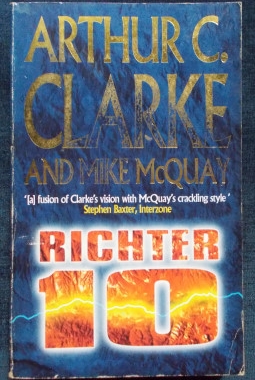An immensely readable and stimulating collection of essays examining the enormous possibilities the human race now has for creativity and destruction. Against Orwell's ominous date 1984 he has deliberately set the hopeful word Spring because he feels the worst of the world's long winter may well be over. Clarke's passionate interest in space exploration, vast knowledge of technological and scientific developments and his informed, optimistic humanism are communicated in a style that will strike a responsive chord in the hearts and minds of all readers concerned for the future of humankind on - and off - Earth.
-

-
 Clarke looks back at the early days of the science fiction field, offering some humorous anecdotes and insightful observations of the Golden Age notables of the genre. He reminisces on Astounding Science Fiction (now Analog) and its effect on him as a schoolboy; it's half Clarke's two-pronged memoirs and half chronicle of his scientific/engineering career. Told with humor and humility and throughout, his lifelong love of learning shines through. Cover art by Chris Consani.
Clarke looks back at the early days of the science fiction field, offering some humorous anecdotes and insightful observations of the Golden Age notables of the genre. He reminisces on Astounding Science Fiction (now Analog) and its effect on him as a schoolboy; it's half Clarke's two-pronged memoirs and half chronicle of his scientific/engineering career. Told with humor and humility and throughout, his lifelong love of learning shines through. Cover art by Chris Consani. -
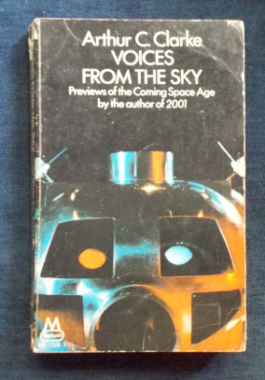 Previews of the coming space age...The universe is full of voices, calling from star to star in myriad tongues. One day we shall join that cosmic conversation, though it may be ages before we cross the mega-mega-miles sundering us from our equals, and our masters. This is Clarke's log of a voyage which has only just begun - Man's odyssey from Earth, his first home, among the planets, to the stars, and across the universe. There are also plenty of snippets of his life slipped into the essays.
Previews of the coming space age...The universe is full of voices, calling from star to star in myriad tongues. One day we shall join that cosmic conversation, though it may be ages before we cross the mega-mega-miles sundering us from our equals, and our masters. This is Clarke's log of a voyage which has only just begun - Man's odyssey from Earth, his first home, among the planets, to the stars, and across the universe. There are also plenty of snippets of his life slipped into the essays. -
 The compelling story of the launching of Prometheus - Earth's first true spaceship - and of the men who made it happen. Dirk Alexson: Chronicler of the greatest space adventure of all time, he was chosen to immortalize the incredible story of the men and their heroic mission. Sir Robert Derwent: Direct-General of Interplanetary -- London Headquarters for the international space-flight project -- he was the man who got the mission off the ground and into the pages of history. Professor Maxton: The world's leading atomic engineer, he designed the huge ship's drive units and he waited with the rest of the world to see if the project would be a success... Cover art by Gordon C. Davies.
The compelling story of the launching of Prometheus - Earth's first true spaceship - and of the men who made it happen. Dirk Alexson: Chronicler of the greatest space adventure of all time, he was chosen to immortalize the incredible story of the men and their heroic mission. Sir Robert Derwent: Direct-General of Interplanetary -- London Headquarters for the international space-flight project -- he was the man who got the mission off the ground and into the pages of history. Professor Maxton: The world's leading atomic engineer, he designed the huge ship's drive units and he waited with the rest of the world to see if the project would be a success... Cover art by Gordon C. Davies. -
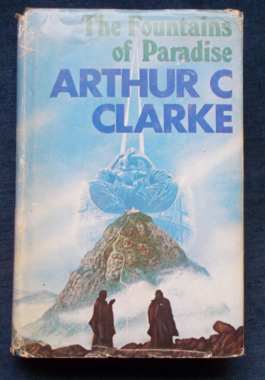 In 2124 A.D. the brilliant engineer Vannevar Morgan has evolved a method of building a gigantic 'Space Elevator' to transport men and materials out of the Earth's atmosphere, thus marking the true beginning of Man's interplanetary civilisation. But there's a major obstacle before this awesome concept can become reality: the only point on Earth suitable for the launch site is the peak of a sacred mountain jealously guarded by monks who have inhabited the site since time immemorial. Will their resistance be overcome? Cover art by Terry Oakes.
In 2124 A.D. the brilliant engineer Vannevar Morgan has evolved a method of building a gigantic 'Space Elevator' to transport men and materials out of the Earth's atmosphere, thus marking the true beginning of Man's interplanetary civilisation. But there's a major obstacle before this awesome concept can become reality: the only point on Earth suitable for the launch site is the peak of a sacred mountain jealously guarded by monks who have inhabited the site since time immemorial. Will their resistance be overcome? Cover art by Terry Oakes. -
 Five hundred years before the events in The Songs of Distant Earth, Earth's sun went nova, destroying Earth and the other planets of the solar system. There was just enough warning to evacuate survivors in hyperships, each carrying one million sleepers in suspended animation, as well as the gene banks of plants and animals. The Magellan, experiencing considerable erosion from interstellar space debris, stops at the planet Thalassa to construct a new shield. The Thalassans are happy to help the interstellar travellers but matters get complicated when the travellers are tempted by the idyllic lifestyle on Thelassa, and the Thelassans are attracted by the adventure of deep-space voyage... and then Commander Lorenson falls in love in Mirissa, a Thelassan girl. Cover art by Michael Whelan.
Five hundred years before the events in The Songs of Distant Earth, Earth's sun went nova, destroying Earth and the other planets of the solar system. There was just enough warning to evacuate survivors in hyperships, each carrying one million sleepers in suspended animation, as well as the gene banks of plants and animals. The Magellan, experiencing considerable erosion from interstellar space debris, stops at the planet Thalassa to construct a new shield. The Thalassans are happy to help the interstellar travellers but matters get complicated when the travellers are tempted by the idyllic lifestyle on Thelassa, and the Thelassans are attracted by the adventure of deep-space voyage... and then Commander Lorenson falls in love in Mirissa, a Thelassan girl. Cover art by Michael Whelan. -
 Here is Arthur C. Clarke at his most impish and light-hearted: This volume includes: Silence Please; Big Game Hunt; Patents Pending; Armaments Race; Critical Mass; The Ultimate Melody; The Pacifist; The Next Tenants; Moving Spirit; The Man Who Ploughed the Sea; The Reluctant Orchid; Cold War; What Goes Up; Sleeping Beauty; The Defestration of Ermintrude Inch. Cover art by David O'Conner.
Here is Arthur C. Clarke at his most impish and light-hearted: This volume includes: Silence Please; Big Game Hunt; Patents Pending; Armaments Race; Critical Mass; The Ultimate Melody; The Pacifist; The Next Tenants; Moving Spirit; The Man Who Ploughed the Sea; The Reluctant Orchid; Cold War; What Goes Up; Sleeping Beauty; The Defestration of Ermintrude Inch. Cover art by David O'Conner. -
 Based on the screenplay by Stanley Kubrick and Arthur C. Clarke. A group of primates is singled out to receive information from a superior outside force which will speed up their development into mankind. Later, men excavate a huge monolith from the Moon's surface - a monolith which emits a strange and, to them, incomprehensible signal. Upon its discovery the monolith launches into deep space, its task of watching over Man, now that he has reached the level of sophistication necessary to find it, being over. This theme continues building into a a massive climax.
Based on the screenplay by Stanley Kubrick and Arthur C. Clarke. A group of primates is singled out to receive information from a superior outside force which will speed up their development into mankind. Later, men excavate a huge monolith from the Moon's surface - a monolith which emits a strange and, to them, incomprehensible signal. Upon its discovery the monolith launches into deep space, its task of watching over Man, now that he has reached the level of sophistication necessary to find it, being over. This theme continues building into a a massive climax. -
 A collection of Clarke's finest shorts including : I Remember Babylon; Summertime On Icarus; Out of the Cradle, Endlessly Orbiting...; Who's There? Hate; Into the Comet; An Ape About the House; Saturn Rising; Let There Be Light; Death and the Senator; Trouble With Time; Before Eden; A Slight Case of Sunstroke; Dog Star; The Road to the Sea. Cover art by Terry Pastor.
A collection of Clarke's finest shorts including : I Remember Babylon; Summertime On Icarus; Out of the Cradle, Endlessly Orbiting...; Who's There? Hate; Into the Comet; An Ape About the House; Saturn Rising; Let There Be Light; Death and the Senator; Trouble With Time; Before Eden; A Slight Case of Sunstroke; Dog Star; The Road to the Sea. Cover art by Terry Pastor. -
 For those of you who are worried about what the neighbors will think, there is what is purported to be an old Martian document which tells us what our nearest neighbor has to say about life on Earth. Clarke explains the proper etiquette for contacting and dealing with aliens from outer space, or what to do if they get here first...Ranging from the light fantastic to the extremely possible, this collection is divided into five sections: Talking of Space; Outward from Earth; The Technological Future; Frontiers of Science; and Son of Dr. Strangelove, Etc. From Martians to Magi, here is Arthur C. Clarke's unforgettable tour of the Universe - known, unknown and yet to come.
For those of you who are worried about what the neighbors will think, there is what is purported to be an old Martian document which tells us what our nearest neighbor has to say about life on Earth. Clarke explains the proper etiquette for contacting and dealing with aliens from outer space, or what to do if they get here first...Ranging from the light fantastic to the extremely possible, this collection is divided into five sections: Talking of Space; Outward from Earth; The Technological Future; Frontiers of Science; and Son of Dr. Strangelove, Etc. From Martians to Magi, here is Arthur C. Clarke's unforgettable tour of the Universe - known, unknown and yet to come. -
 After a terrifying nightmare in outer space, Walter Franklin needs to discover a reason for living. He found it in the ocean depths when strangers defied life to give it back to him. Freedom to roam above and below the great waters should have been enough for any man - but Franklin was haunted by an echo - an echo that could solve the oldest mystery of the sea. Cover art by W. F. Phillipps.
After a terrifying nightmare in outer space, Walter Franklin needs to discover a reason for living. He found it in the ocean depths when strangers defied life to give it back to him. Freedom to roam above and below the great waters should have been enough for any man - but Franklin was haunted by an echo - an echo that could solve the oldest mystery of the sea. Cover art by W. F. Phillipps. -
 In 1973 Sidgwick and Jackson published The Best Of Arthur C. Clarke 1937 - 1972 as one volume. In 1977, they reprinted it as two volumes: The Best Of Arthur C. Clarke Volume 1 1937 - 1955 and The Best Of Arthur C. Clarke Volume 2 1956 - 1972. In this volume: Venture To The Moon: Six stories in one of the first crewed mission to the Moon as a joint American-Russian-British mission, narrated by the British team commander. Into The Comet: an expedition sets out to discover what the comet is like at its core - mission accomplished...but when the ship's computer goes haywire, it will need all the crew's ingenuity to make it home again. Summertime On Icarus: Lone scientist Colin Sherrard is stranded on Icarus - an asteroid too close to the sun. Death And The Senator: An ambitious senior US Senator, who has sacrificed everything and everyone - friends, his wife, his daughter and his grandchildren - in pursuit of a political career contracts a terminal illness. His only hope for a cure is to accept a innovative treatment which he campaigned against funding... a decision for which he will be branded a hypocrite. Hate: When a downed Sputnik lands near a mussel-collecting boat, a Hungarian crewman wants revenge for what the Russians did to his family. Sunjammer (Variant Title: The Wind From The Sun): A spaceship designer develops a lightweight spacecraft with a large area of solar sail to participate sun-yacht racing. A Meeting With Medusa: When an experimental helium airship crashes, captain Howard Falcon is severely injured and takes over a year to recover. He then proposes an expedition to explore the atmosphere of Jupiter...
In 1973 Sidgwick and Jackson published The Best Of Arthur C. Clarke 1937 - 1972 as one volume. In 1977, they reprinted it as two volumes: The Best Of Arthur C. Clarke Volume 1 1937 - 1955 and The Best Of Arthur C. Clarke Volume 2 1956 - 1972. In this volume: Venture To The Moon: Six stories in one of the first crewed mission to the Moon as a joint American-Russian-British mission, narrated by the British team commander. Into The Comet: an expedition sets out to discover what the comet is like at its core - mission accomplished...but when the ship's computer goes haywire, it will need all the crew's ingenuity to make it home again. Summertime On Icarus: Lone scientist Colin Sherrard is stranded on Icarus - an asteroid too close to the sun. Death And The Senator: An ambitious senior US Senator, who has sacrificed everything and everyone - friends, his wife, his daughter and his grandchildren - in pursuit of a political career contracts a terminal illness. His only hope for a cure is to accept a innovative treatment which he campaigned against funding... a decision for which he will be branded a hypocrite. Hate: When a downed Sputnik lands near a mussel-collecting boat, a Hungarian crewman wants revenge for what the Russians did to his family. Sunjammer (Variant Title: The Wind From The Sun): A spaceship designer develops a lightweight spacecraft with a large area of solar sail to participate sun-yacht racing. A Meeting With Medusa: When an experimental helium airship crashes, captain Howard Falcon is severely injured and takes over a year to recover. He then proposes an expedition to explore the atmosphere of Jupiter... -
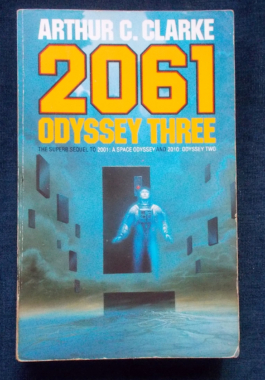 In 2061, when two Suns share the skies of Earth, Halley's Comet returns to the inner Solar System. Soon the fates of two spacefaring expeditions are entwined by human necessity and the immutable laws of astrophysics. Centenarian Heywood Floyd must again confront Dave Bowman, a newly independent HAL and the limitless power of an alien race that has decided humanity must play a part in the evolution of the galaxy - whether it wants to or not...Cover at by Michael Whelan.
In 2061, when two Suns share the skies of Earth, Halley's Comet returns to the inner Solar System. Soon the fates of two spacefaring expeditions are entwined by human necessity and the immutable laws of astrophysics. Centenarian Heywood Floyd must again confront Dave Bowman, a newly independent HAL and the limitless power of an alien race that has decided humanity must play a part in the evolution of the galaxy - whether it wants to or not...Cover at by Michael Whelan. -
 2012: a hundred years after the sinking of the Titanic. Two of the world's most powerful corporations, each headed by an eccentric and brilliant man, race to find a way to raise and preserve the doomed luxury ocean liner. Two multi-billion-dollar technologies are tested in a plan to raise the ship that will stun the world and create a media feeding frenzy. The rival CEOs gather and together the twenty-first century's most brilliant minds, including Roy Emerson, technical problem solver and the prodigy behind the glass microsphere; computer geniuses Donald and Edith Craig, darkly fixated by the enigmatic mathematical "Mandelbrot-Set"; and the grand old man of deep-water operations, Jason Bradley, pilot of a state-of-the-art high-pressure heliox suit named "Jim". Two adversary technologies under four hundred atmospheres of pressure at the bottom of the ocean. To each of the undersea explorers, the quest to uncover the secrets of the wreck and to reclaim her for all time becomes an obsession...and for some, a fatal one. Cover art by Paul Swendsen.
2012: a hundred years after the sinking of the Titanic. Two of the world's most powerful corporations, each headed by an eccentric and brilliant man, race to find a way to raise and preserve the doomed luxury ocean liner. Two multi-billion-dollar technologies are tested in a plan to raise the ship that will stun the world and create a media feeding frenzy. The rival CEOs gather and together the twenty-first century's most brilliant minds, including Roy Emerson, technical problem solver and the prodigy behind the glass microsphere; computer geniuses Donald and Edith Craig, darkly fixated by the enigmatic mathematical "Mandelbrot-Set"; and the grand old man of deep-water operations, Jason Bradley, pilot of a state-of-the-art high-pressure heliox suit named "Jim". Two adversary technologies under four hundred atmospheres of pressure at the bottom of the ocean. To each of the undersea explorers, the quest to uncover the secrets of the wreck and to reclaim her for all time becomes an obsession...and for some, a fatal one. Cover art by Paul Swendsen. -
 Clarke's most significant and prophetic non-fiction writings, gathered together to present a personal view of the twentieth century. He predicts the role of geosynchronous satellites decades before they existed; reports from Kennedy Space Centre; discusses Star Wars, giant squid and numerous other fascinating and philosophical topics.
Clarke's most significant and prophetic non-fiction writings, gathered together to present a personal view of the twentieth century. He predicts the role of geosynchronous satellites decades before they existed; reports from Kennedy Space Centre; discusses Star Wars, giant squid and numerous other fascinating and philosophical topics. -
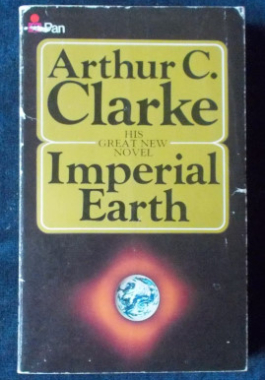 Duncan Makenzie is traveling from Titan, a moon of Saturn, to Earth, as a diplomatic guest of the United States for the celebration of its Quincentennial in the year 2276. Titan, an independent republic, was originally colonized from Earth three generations earlier. Duncan's initial challenge is to prepare, physically and intellectually, for the 500-million-mile trip to Earth. Once there, he is caught up in a sweep of new experiences, including the social and political whirl in Washington, a strange visit to a carefully preserved ancient city once prominent in the 20th century, and a search for and meeting with a woman he loved since she visited Titan years before.
Duncan Makenzie is traveling from Titan, a moon of Saturn, to Earth, as a diplomatic guest of the United States for the celebration of its Quincentennial in the year 2276. Titan, an independent republic, was originally colonized from Earth three generations earlier. Duncan's initial challenge is to prepare, physically and intellectually, for the 500-million-mile trip to Earth. Once there, he is caught up in a sweep of new experiences, including the social and political whirl in Washington, a strange visit to a carefully preserved ancient city once prominent in the 20th century, and a search for and meeting with a woman he loved since she visited Titan years before. -
 Out among the moons of Jupiter, the empty spacecraft Discovery and the enigmatic alien monolith still float it the silence of space, mute witnesses to the mysterious disappearance of astronaut David Bowman through the 'Star Gate' nine years before. The Leonov is on its way, carrying a joint Soviet American scientific team on a mission of investigation and recovery, but the outcome will be beyond the wildest imaginings of any mere humans involved. Cover art by Michael Whelan.
Out among the moons of Jupiter, the empty spacecraft Discovery and the enigmatic alien monolith still float it the silence of space, mute witnesses to the mysterious disappearance of astronaut David Bowman through the 'Star Gate' nine years before. The Leonov is on its way, carrying a joint Soviet American scientific team on a mission of investigation and recovery, but the outcome will be beyond the wildest imaginings of any mere humans involved. Cover art by Michael Whelan. -
 Written in 1963 and set in 21st century, a cargo hover ship makes an emergency stop in the Midwest for repairs. Johnny Clinton, adventurous teenager, sneaks on board. A day later the craft is shipwrecked in the southern Pacific Ocean and starts to sink. The crew, unaware of the stowaway, leaves on a lifeboat. Johnny climbs onto a large piece of debris and is rescued by a pod of dolphins who push his raft 100 miles to an island in the heart of Australia's Great Barrier Reef. There, Johnny meets the brilliant and eccentric Professor Kazan, who has dedicated his life to the study of dolphin communication. Johnny's adventures include killer whales, hurricanes and an underwater conspiracy. Cover art by Christine Mowlan. Illustrations by Robin Anderson.
Written in 1963 and set in 21st century, a cargo hover ship makes an emergency stop in the Midwest for repairs. Johnny Clinton, adventurous teenager, sneaks on board. A day later the craft is shipwrecked in the southern Pacific Ocean and starts to sink. The crew, unaware of the stowaway, leaves on a lifeboat. Johnny climbs onto a large piece of debris and is rescued by a pod of dolphins who push his raft 100 miles to an island in the heart of Australia's Great Barrier Reef. There, Johnny meets the brilliant and eccentric Professor Kazan, who has dedicated his life to the study of dolphin communication. Johnny's adventures include killer whales, hurricanes and an underwater conspiracy. Cover art by Christine Mowlan. Illustrations by Robin Anderson. -
 A fabulous representation from the founding father of modern sci-fi. This volume includes: Travel by Wire (1937); Retreat From Earth (1938); The Awakening (1942); Whacky (1942); Castaway (1947); History Lesson (1949); Hide And Seek (1949); Second Dawn (1951); The Sentinel (1954); The Star (1955); Refugee (1955); Venture to the Moon (1956); Into The Comet (1960); Summertime On Icarus (1960); Death And The Senator (1961); Hate (1961); Sunjammer (1965); A Meeting With Medusa (1972). Cover art by Chris Foss.
A fabulous representation from the founding father of modern sci-fi. This volume includes: Travel by Wire (1937); Retreat From Earth (1938); The Awakening (1942); Whacky (1942); Castaway (1947); History Lesson (1949); Hide And Seek (1949); Second Dawn (1951); The Sentinel (1954); The Star (1955); Refugee (1955); Venture to the Moon (1956); Into The Comet (1960); Summertime On Icarus (1960); Death And The Senator (1961); Hate (1961); Sunjammer (1965); A Meeting With Medusa (1972). Cover art by Chris Foss. -
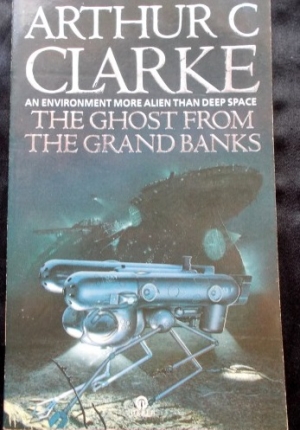 2010 - almost the centennial of the sinking of the Titanic. The remains of the great ocean liner lie 4 kilometres down on the Grand Banks of the Atlantic Ocean, an endless reminder of man's technological frailty in the face of natural perils. But now, the urge to raise the wreck is irrestistible. From the West comes one solution; from the East another. Both are marvels of technological imagination; both can succeed. But there are other powers at work and the wreck may yet hold a surprise or two for those who would return her to the eyes of the world.
2010 - almost the centennial of the sinking of the Titanic. The remains of the great ocean liner lie 4 kilometres down on the Grand Banks of the Atlantic Ocean, an endless reminder of man's technological frailty in the face of natural perils. But now, the urge to raise the wreck is irrestistible. From the West comes one solution; from the East another. Both are marvels of technological imagination; both can succeed. But there are other powers at work and the wreck may yet hold a surprise or two for those who would return her to the eyes of the world. -
 The year: 2142 A.D. The place: Taprobane, a tropical island paradise. The project: A giant space elevator to transport men and materials to a point outside the the earth's atmosphere. The man: Ace engineer Vannevar Morgan. The problem: The only suitable site is a sacred mountain jealously guarded by monks...Cover art by Chris Moore.
The year: 2142 A.D. The place: Taprobane, a tropical island paradise. The project: A giant space elevator to transport men and materials to a point outside the the earth's atmosphere. The man: Ace engineer Vannevar Morgan. The problem: The only suitable site is a sacred mountain jealously guarded by monks...Cover art by Chris Moore. -
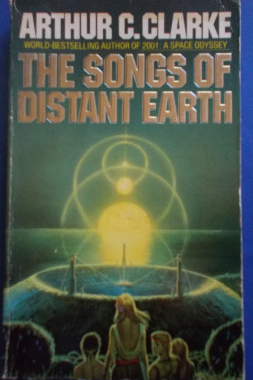 When Earth's sun went nova, the Magellan barely escaped in time, with its precious cargo of one million sleepers and gene banks of plants and animals. Five hundred years into the voyage they stopped for repairs on the idyllic planet of Thalassa. But whilst the awakened Earth people envied them their stable, harmonious world, the hospitable Thalassans were drawn to the long quest of the interstellar voyagers. And when Lt Commander Loren Lorenson met beautiful Thalassan Mirissa, their destinies became inextricably and tragically entwined. Cover art by Michael Whelan.
When Earth's sun went nova, the Magellan barely escaped in time, with its precious cargo of one million sleepers and gene banks of plants and animals. Five hundred years into the voyage they stopped for repairs on the idyllic planet of Thalassa. But whilst the awakened Earth people envied them their stable, harmonious world, the hospitable Thalassans were drawn to the long quest of the interstellar voyagers. And when Lt Commander Loren Lorenson met beautiful Thalassan Mirissa, their destinies became inextricably and tragically entwined. Cover art by Michael Whelan. -
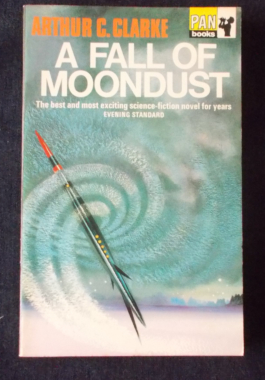 A lunar cruise ends in disaster after a moonquake sinks the cruiser Selene beneath a sea of liquid-fine lunar dust on the Moon's Sea of Thirst. Facing enormous environmental barriers, the rescue team finds their courage, ingenuity, and resources tested to the breaking point - as trapped passengers and crew slowly run out of time...
A lunar cruise ends in disaster after a moonquake sinks the cruiser Selene beneath a sea of liquid-fine lunar dust on the Moon's Sea of Thirst. Facing enormous environmental barriers, the rescue team finds their courage, ingenuity, and resources tested to the breaking point - as trapped passengers and crew slowly run out of time... -

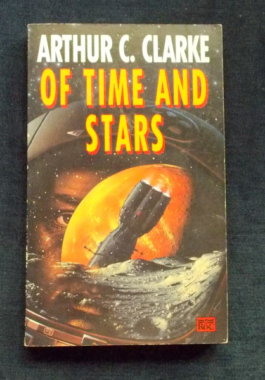 Eighteen shorts by the master of sci-fi: In this volume: The Nine Billion Names of God: A Tibetan monastery hires a super-computer to list the nine billion names of God - with horrific results. All the Time in the World: Time is altered so that the world's treasures can be stolen. But who's behind it? Encounter at Dawn: A survey starship with three scientists aboard find a planet on the far rim of the Milky Way, inhabit by bipeds very similar to themselves, but with vastly lower levels of technology. The Sentinel: A lunar exploration mission stumbles across a sentinel left by an ancient space-faring civilisation. Into the Comet: A space ship exploring the nucleus of a comet experiences a dangerous computer malfunction. 'If I Forget Thee, Oh Earth...': A young lad living in a lunar colony is curious about his home planet of Earth. The Forgotten Enemy: After the solar system dives into a cloud of cosmic dust and Britain's climate turns from temperate to arctic, a professor who has elected to stay with his books gets to observe some very sudden changes. The Reluctant Orchid: Keating, a timid orchid breeder with an overbearing aunt, comes across a carnivorous orchid - can he use it to commit the perfect murder and get rid of his hateful aunt? Security Check: A set designer for a science fiction TV programme seems to get too close to the truth. No Morning After: An advanced alien race attempts to warn humans that the Sun is about to explode - but the only human they can find is a drunk! Who's There? A space-station supervisor, receives a call that there is a small object in the same orbital projectory and that someone needs to go retrieve it. He decides to go himself - but has he just put on a haunted space-suit? Hide and Seek: During an interplanetary war, an agent must outrun the enemy and get his vital information to his mother ship. Robin Hood, FRS: A tale of the efforts by the joint expedition members to recover an automatic supply rocket that has landed just out of reach, through a very unorthodox method. Feathered Friend: Sven, a space construction worker, smuggles his pet canary aboard the space station. An Ape About the House: A bored housewife encourages her laboratory-bred serving ape to take up painting - and astonishes the art world. Green Fingers: A Russian team member - a botanist - secretly engineers plant life that could survive on the Moon's surface. Trouble with the Natives: Aliens visit a small English village and get frustrated with trying to communicate! Cover art by Peter Elson.
Eighteen shorts by the master of sci-fi: In this volume: The Nine Billion Names of God: A Tibetan monastery hires a super-computer to list the nine billion names of God - with horrific results. All the Time in the World: Time is altered so that the world's treasures can be stolen. But who's behind it? Encounter at Dawn: A survey starship with three scientists aboard find a planet on the far rim of the Milky Way, inhabit by bipeds very similar to themselves, but with vastly lower levels of technology. The Sentinel: A lunar exploration mission stumbles across a sentinel left by an ancient space-faring civilisation. Into the Comet: A space ship exploring the nucleus of a comet experiences a dangerous computer malfunction. 'If I Forget Thee, Oh Earth...': A young lad living in a lunar colony is curious about his home planet of Earth. The Forgotten Enemy: After the solar system dives into a cloud of cosmic dust and Britain's climate turns from temperate to arctic, a professor who has elected to stay with his books gets to observe some very sudden changes. The Reluctant Orchid: Keating, a timid orchid breeder with an overbearing aunt, comes across a carnivorous orchid - can he use it to commit the perfect murder and get rid of his hateful aunt? Security Check: A set designer for a science fiction TV programme seems to get too close to the truth. No Morning After: An advanced alien race attempts to warn humans that the Sun is about to explode - but the only human they can find is a drunk! Who's There? A space-station supervisor, receives a call that there is a small object in the same orbital projectory and that someone needs to go retrieve it. He decides to go himself - but has he just put on a haunted space-suit? Hide and Seek: During an interplanetary war, an agent must outrun the enemy and get his vital information to his mother ship. Robin Hood, FRS: A tale of the efforts by the joint expedition members to recover an automatic supply rocket that has landed just out of reach, through a very unorthodox method. Feathered Friend: Sven, a space construction worker, smuggles his pet canary aboard the space station. An Ape About the House: A bored housewife encourages her laboratory-bred serving ape to take up painting - and astonishes the art world. Green Fingers: A Russian team member - a botanist - secretly engineers plant life that could survive on the Moon's surface. Trouble with the Natives: Aliens visit a small English village and get frustrated with trying to communicate! Cover art by Peter Elson. -
 After a terrifying nightmare in outer space, Walter Franklin had to discover a reason for living. He found it in the ocean depths, where strangers defied death to give life back to him. Freedom to roam above and below the great waters would have been enough for any man - but Franklin is haunted by the memory of an echo - an echo that could solve the oldest mystery of the sea...Cover art by W. F. Phillipps.
After a terrifying nightmare in outer space, Walter Franklin had to discover a reason for living. He found it in the ocean depths, where strangers defied death to give life back to him. Freedom to roam above and below the great waters would have been enough for any man - but Franklin is haunted by the memory of an echo - an echo that could solve the oldest mystery of the sea...Cover art by W. F. Phillipps. -
 The Overlords appeared suddenly over every city - intellectually, technologically, and militarily superior to humankind. Benevolent, they made few demands: unify the Earth, eliminate poverty and end war. With little rebellion, humankind agreed, and a golden age began. But at what cost? With the advent of peace, man ceases to strive for creative greatness and a malaise settles over the human race. To those who resist, it becomes evident that the Overlords have an agenda of their own. As civilisation approaches the crossroads, will the Overlords spell the end for humankind...or the beginning? Cover art by W. F. Phillipps.
The Overlords appeared suddenly over every city - intellectually, technologically, and militarily superior to humankind. Benevolent, they made few demands: unify the Earth, eliminate poverty and end war. With little rebellion, humankind agreed, and a golden age began. But at what cost? With the advent of peace, man ceases to strive for creative greatness and a malaise settles over the human race. To those who resist, it becomes evident that the Overlords have an agenda of their own. As civilisation approaches the crossroads, will the Overlords spell the end for humankind...or the beginning? Cover art by W. F. Phillipps.


